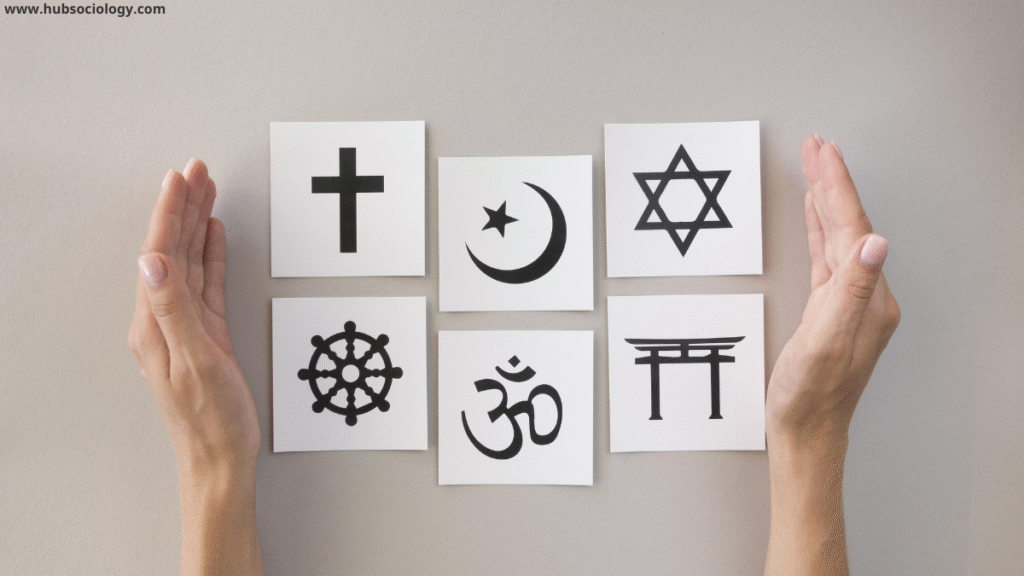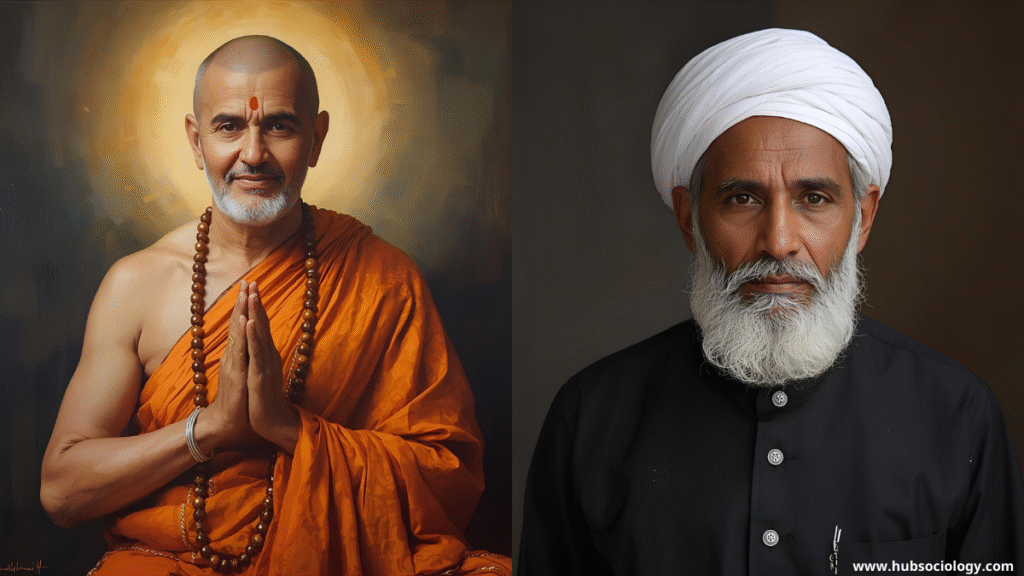Religion has always been more than a matter of private belief; it often shapes collective life, moral boundaries, and national identity. From the rise of ancient empires to the modern nation-state and plays an active role in the Religion in Public Sphere—a domain where citizens deliberate, express values, and negotiate the norms that govern society. The relationship between religion and the public sphere can be understood in different ways: through official religion, where the state formally endorses one faith; civil religion, where religious symbols and rituals legitimize political authority; and religious nationalism, where religious identity becomes intertwined with the national project. Examining these forms in sociological perspective reveals how religion interacts with politics, social cohesion, and collective identity.
Religion in the Public Sphere: A Sociological Framework
The concept of the public sphere, popularized by Jürgen Habermas, refers to the space where citizens communicate and form public opinion outside the state and the market. Religion enters this space as a moral authority, a symbolic system, and a source of collective identity. Sociologists see religion in the public sphere not only as belief but also as social practice—rituals, discourses, and institutions that influence law, policy, and culture.
Key sociological perspectives highlight different aspects:
- Durkheimian View: Religion contributes to social solidarity by affirming collective conscience and moral order.
- Weberian View: Religion can drive social change, providing values that shape economic, political, and cultural development.
- Conflict Perspective: Religion in the public sphere often reproduces social inequalities, legitimizes power, or fosters conflict along communal lines.
Against this backdrop, the three models—official religion, civil religion, and religious nationalism—demonstrate how religion operates within political and social life.

Official Religion
Meaning and Features
An official religion exists when the state formally recognizes a specific faith as its religion. This arrangement grants privileges to one religious group in matters such as state funding, public education, or constitutional recognition. Examples include Islam in Saudi Arabia and Pakistan, Christianity in Greece and England, and Buddhism in Bhutan and Thailand.
Features include:
- Legal recognition: The constitution or legal system embeds the official religion.
- State patronage: The state may fund religious institutions, clergy, or religious education.
- Exclusionary potential: Minority religions may face discrimination or marginalization.
Sociological Implications
- Integration and Authority: Official religion often legitimizes political authority, portraying rulers as divinely sanctioned.
- Social Hierarchy: It creates a religious hierarchy that privileges some groups while subordinating others.
- Social Tensions: While official religion may unify the majority, it risks alienating minorities, generating conflict.
For instance, in Iran, Shi’a Islam as official religion shapes both governance and law, while non-Muslim minorities face restrictions. Similarly, the Church of England maintains ceremonial influence, reflecting historical ties between monarchy and Christianity, though modern Britain is largely secular.
Thus, official religion demonstrates the deep entanglement of religion and power in the public sphere.
Civil Religion
Meaning and Concept
Civil religion, introduced by sociologist Robert Bellah, refers to the quasi-religious beliefs, symbols, and rituals that sacralize the nation-state. Unlike official religion, civil religion is not tied to one faith; rather, it mobilizes a broad religious sentiment to reinforce collective loyalty.
Examples include:
- The invocation of “God” in U.S. presidential speeches and the phrase “In God We Trust.”
- National days of remembrance, flag salutes, and anthems that take on sacred overtones.
- Martyrs’ memorials or rituals that honor soldiers as if they embody national sacrifice.
Sociological Role
- Cohesion: Civil religion fosters unity in pluralistic societies, creating a sacred canopy over diverse groups.
- Legitimacy: It legitimizes political authority by framing it in moral or divine terms.
- Continuity: It binds citizens to historical traditions and shared destiny.
For example, in the United States, civil religion bridges denominational differences by sacralizing the nation itself. Political leaders often speak of America’s divine mission or moral responsibility, thereby combining religion and patriotism.
Critical View
However, civil religion can blur boundaries between religion and politics. Critics argue it risks instrumentalizing religion for political ends, promoting conformity, and silencing dissent. In multicultural societies, civil religion must be inclusive; otherwise, it marginalizes minority voices.
Religious Nationalism
Meaning and Nature
Religious nationalism arises when religious identity becomes inseparable from national identity. It suggests that the nation is defined not only by territory or language but also by shared faith. This fusion often emerges in periods of colonial struggle, modernization, or perceived cultural threat.

Examples include:
- Hindutva in India, where Hindu identity is tied to national identity.
- Zionism in Israel, which connects Jewish identity to statehood.
- Islamic nationalism in countries like Pakistan, where Islam forms the basis of national unity.
Sociological Dimensions
- Identity and Belonging: Religious nationalism provides a strong collective identity, offering meaning in times of uncertainty.
- Mobilization: It mobilizes populations for political movements, wars of independence, or social reforms.
- Exclusionary Boundaries: By linking religion with nationality, it often excludes or stigmatizes minorities, creating communal divisions.
- Conflict and Violence: In extreme forms, religious nationalism has fueled ethnic conflicts, civil wars, and genocide.
Illustrations
- In India, religious nationalism has shaped debates over citizenship, minority rights, and secularism.
- In Israel, religion defines state policies on land, citizenship, and security.
- In Sri Lanka, Buddhist nationalism has influenced ethnic conflict with Tamil minorities.
Thus, religious nationalism demonstrates the profound political force of religion in shaping both unity and division in the public sphere.
Comparative Analysis
While official religion, civil religion, and religious nationalism all represent religion in the public sphere, they operate differently:
- Official Religion: Institutionalized, legal, and state-centric, privileging one faith.
- Civil Religion: Symbolic and unifying, creating sacred legitimacy for the nation without endorsing one denomination.
- Religious Nationalism: Ideological and identity-driven, merging religion with national consciousness.
From a sociological lens, these forms reflect varying strategies of integrating religion into public life, each with distinct consequences for pluralism, social cohesion, and conflict.
Challenges in Modern Societies
Globalization, secularization, and pluralism have complicated the role of religion in public life. Sociologists note tensions such as:
- Secularization vs. Resurgence: While secularization predicts the decline of religion, many societies witness its resurgence through nationalism or fundamentalism.
- Pluralism: In multicultural societies, privileging one religion or form of civil religion risks marginalizing minorities.
- Global Conflict: Religious nationalism increasingly shapes global geopolitics, from Middle East conflicts to cultural wars in Europe and Asia.
- Democracy: The intertwining of religion and politics raises concerns about equality, freedom of belief, and human rights.
Conclusion
Religion in the public sphere is not a relic of pre-modern times but a dynamic force that continues to shape modern societies. Through official religion, it legitimizes authority; through civil religion, it sacralizes the nation; and through religious nationalism, it fuses identity with politics. Sociologically, these forms highlight how religion provides meaning, fosters solidarity, and structures power—but also how it can reproduce inequality, marginalization, and conflict.

As societies grow increasingly diverse, the challenge lies in balancing religion’s public role with democratic values of inclusivity, pluralism, and freedom. The sociological study of official religion, civil religion, and religious nationalism thus reveals the enduring complexity of religion as both a source of unity and a site of contestation in the modern public sphere.
Do you like this this Article ? You Can follow as on :-
Facebook – https://www.facebook.com/hubsociology
Whatsapp Channel – https://whatsapp.com/channel/0029Vb6D8vGKWEKpJpu5QP0O
Gmail – hubsociology@gmail.com
Exam-style questions
5 Marks Questions
- Define the concept of Religion in Public Sphere in sociological terms.
- Differentiate between official religion and civil religion within the context of Religion in Public Sphere.
- Mention any two sociological perspectives on the role of Religion in Public Sphere.
- Give two examples of how civil religion manifests as part of Religion in Public Sphere.
- What is meant by religious nationalism in relation to Religion in Public Sphere?
10 Marks Questions
- Discuss the sociological significance of official religion in shaping Religion in Public Sphere.
- Explain Robert Bellah’s concept of civil religion as a form of Religion in Public Sphere.
- Critically examine the challenges faced by multicultural societies in balancing secularism with Religion in Public Sphere.
- Compare official religion and religious nationalism as expressions of Religion in Public Sphere.
- How does globalization affect the dynamics of Religion in Public Sphere in contemporary societies?
15 Marks Questions
- Examine the sociological aspects of Religion in Public Sphere with reference to official religion, civil religion, and religious nationalism.
- “Religious nationalism often blurs the boundary between faith and national identity.” Discuss this statement with examples from Religion in Public Sphere.
- Evaluate the relevance of civil religion in modern democracies as part of Religion in Public Sphere.
- Critically analyze how Religion in Public Sphere can be both a source of social cohesion and social conflict.
- Discuss the interplay of secularization and resurgence of religion in shaping the modern experience of Religion in Public Sphere.
